Population
Males outnumbered females by 1.7 percent in terms of total population
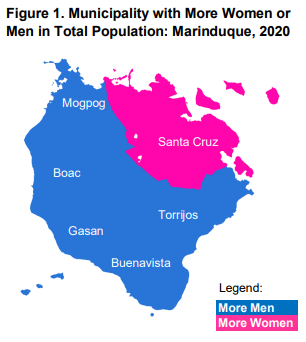
According to the results of the 2020 Census of Population and Housing (2020 CPH), as of May 1, 2020, Marinduque had a total population of 239,207. (Table 1)
More than half or 50.41 percent (120,592 persons) of the total population were male, while the remaining 49.59 percent (118,615 persons) were female. (Table 1)
Of the six municipalities in the province, five are dominated with men, and only the municipality of Santa Cruz is women-dominated. (Figure 1)

Males outnumbered females by 1.6 percent in terms of household population
Of the province’s total population, 99.8 percent or 238,830 persons form part of the household population. Men dominated the province’s household population with 120,345 persons or 50.4 percent while women comprised the remaining 49.6 percent or 118,485 persons.
Among the municipalities in the province, Boac registered the largest household population for both men and women. (Figure 2)
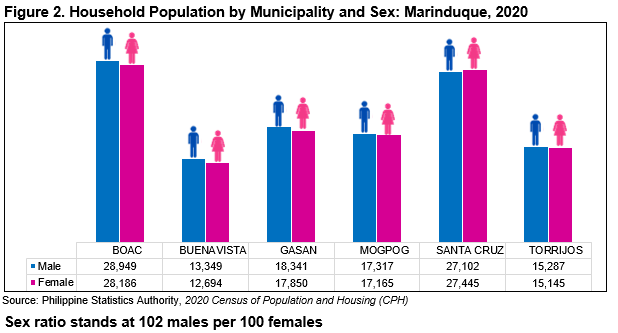
Marinduque’s sex ratio was calculated to be 102 in 2020. This means that there were 102 males for every 100 females. The sex ratio was slightly lower than in 2015, with 101 males for every 100 females. (Table 2 and Figure 3)
In 2020, children under the age of 15 had a sex ratio of 108 males per 100 females, while those aged 15 to 64 had a sex ratio of 104 males per 100 females. Furthermore, the sex ratio among those aged 65 and up was 69 males for every 100 females. This indicates that the majority of the younger generation were males, and the older generation were females. Furthermore, this indicates that females have a longer life expectancy than males, or that males have a higher mortality rate than females in older age groups. (Table 2)
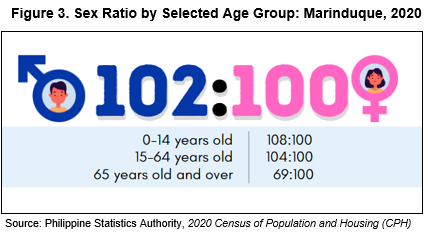
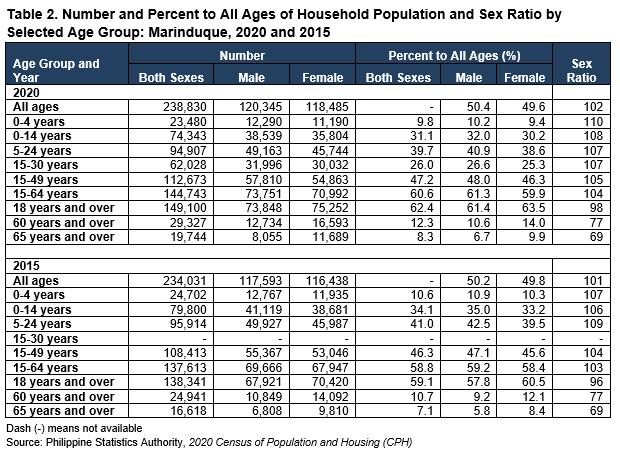
There are more males than females in children under five years old
Children under the age of five made up 9.8 percent (23,480 persons) of the household population, which is slightly lower than the 10.6 percent (24,702 persons) recorded in 2015. The sex ratios in 2015 and 2020 were 107 males per 100 females, and 110 males per 100 females, respectively. (Table 2 and Figure 4)
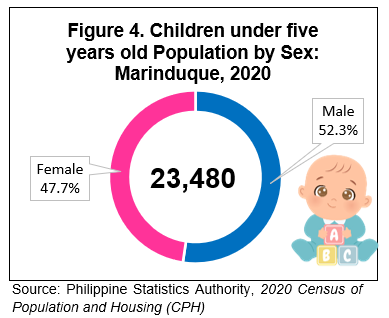
School-age population accounted for 39.7 percent of the total household population
In 2020, the school-age population (5 to 24 years old) accounted for 39.7 percent (94,907 persons) of the total household population of the province, down from 41.0 percent (95,914 persons) in 2015. Of this figure, 51.8 percent, or 49,163 persons, were males, while the remaining 48.2 percent, or 45,744 persons, were females. (Table 2 and Figure 5)
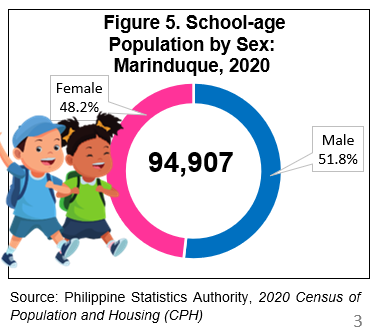
More than half of the youth population were male
Youth, or persons whose age ranges from 15 to 30 years, totaled 62,028 individuals or about 26.0 percent of the household population in 2020. In the Philippines, individuals of this age group are considered of voting age for the Sangguniang Kabataan under Republic Act No. 8044 (Sangguniang Kabataan Act of 2015). (Table 2 and Figure 6)
In 2020, male youth outnumbered female youth by 6.5 percent, or 1,964 persons. Male youth made up 51.6 percent (31,996 persons) and female youth made up 48.4 percent (30,032 persons) of the total youth population. (Table 2 and Figure 6)
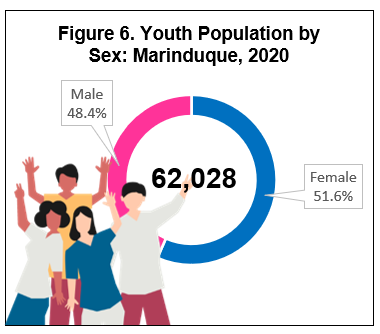
Women constituted more than half to the Senior citizens population
People aged 60 and up are considered senior citizens in the Philippines. In Marinduque, they accounted for 12.3 percent (29,327 persons) of the household population in 2020, up from 10.7 percent (24,941 persons) in 2015. In 2020, there were more females (56.6%) than males (43.4%) among senior citizens. The same trend was observed in 2015. (Table 2 and Figure 7)

More than half of the working-age or economically-active population were men
Among young dependents, defined as those under the age of 15 years, there was a higher proportion of males, accounting for 51.8 percent, compared to females, who represented 48.2 percent. (Table 2 and Figure 8)
Similarly, within the working-age or economically-active population (15-64 years old), males were also predominant, constituting 50.9 percent, while females made up 49.1 percent of this demographic group. (Table 2 and Figure 8)
Conversely, among the older dependents aged 65 years and over, females outnumbered males significantly, with females comprising 59.2 percent compared to 40.8 percent males. The same trend was also observed in 2015. (Table 2 and Figure 8)
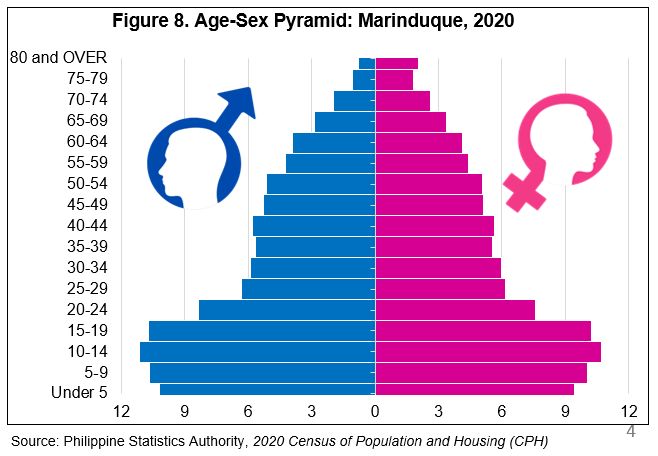
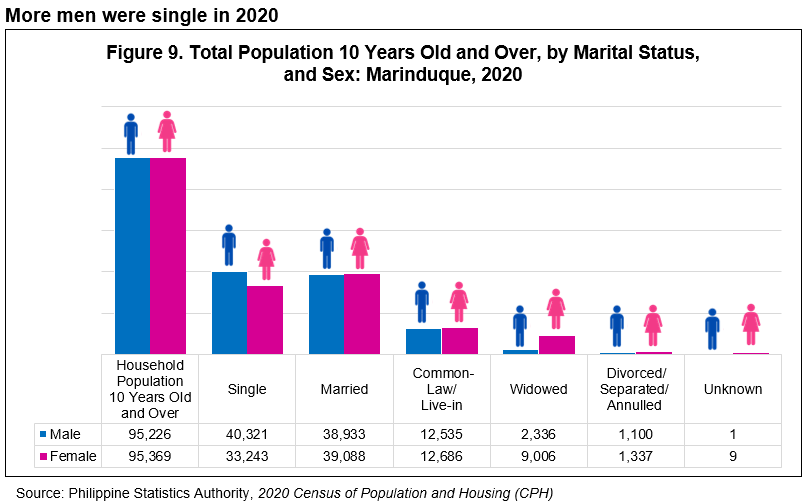
In 2020, among Marinduque's household population, which totaled 190,595 individuals aged 10 years and over, women outnumbered men by 0.2 percent.
Moreover, the marital status distribution revealed notable disparities between sex. A higher proportion of males (42.3%) were single compared to females (34.9%), indicating a greater prevalence of singlehood among males. Conversely, slightly more females (41.0%) were married than males (40.9%), demonstrating a subtle gender difference in marital status. Moreover, there was a significant gender gap in the widowed category, with 9.4 percent of females compared to only 2.5 percent of males being widowed. However, in terms of common-law or live-in relationships, the distribution was relatively equal, with approximately 13.3 percent of females and 13.2 percent of males in this category. (Figure 9)
Vital Statistics
More men were born in 2022
In 2022, a total of 2,912 children were born in Marinduque. Of this total, 1,555 were males, which is 14.6 percent higher than the number of females born, at 1,357. This shows a ratio of 115 males per 100 females, which means for every 100 female children born, there are115 males. (Figure 10)
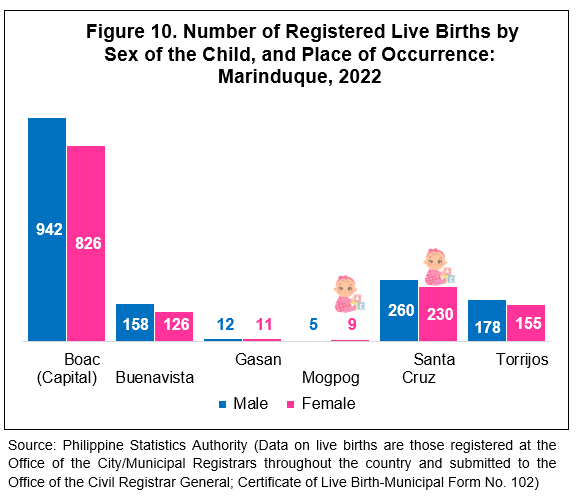
In terms of the place of occurrence, the municipality of Boac registered the highest number of births with 1,768 children. Moreover, Boac registered the highest number of males and females born. Mogpog, on the other hand, registered the lowest number of births with 14 children, from which 5 were males and 9 were females. (Figure 10)

In 2022, the month of September recorded the highest number of births, with 321 children born. Out of this total, 169 were males and152 were females. On the contrary, February recorded the lowest number of births, with only 197 births. (Figure 11)
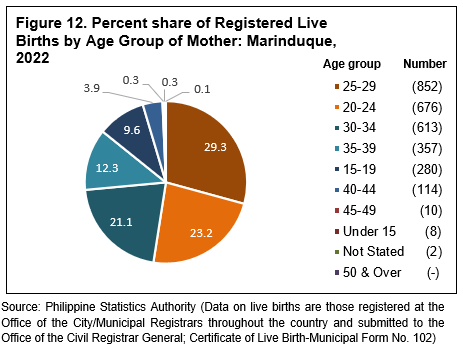
Mothers at aged 25-29 topped the highest birth-giving statistics
In 2022, most of the registered births were from mothers in the age range of 25-29, totaling 852 births, followed by 20-24 with 676 births, and 30-34 with 613 births. It is notable that there were eight births recorded for mothers under 15 years old. (Figure 12)
Most marriages involved individuals aged 25-29 years old
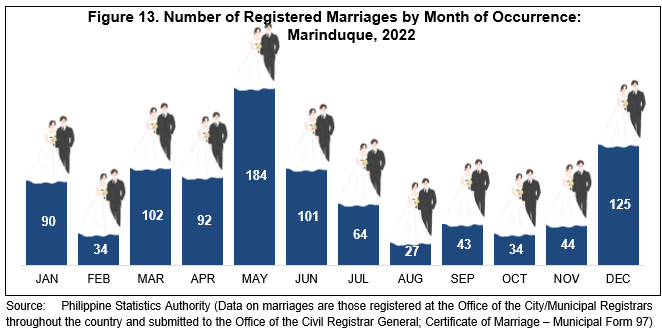
In 2022, a total of 940 marriages were recorded, with the highest number occurring in May (184 marriages) and the lowest in August (27 marriages) . (Figure 13)
For men, the majority of marriages involved those aged 25-29 (373 men), while the least were in the age group 55-59 (2 men). Interestingly, there were recorded marriages for men aged 60 years and over (6 men) and for those aged 15-19 (3 men). (Figure 14)
Similarly, for women, the most common age group for marriages was 25-29 (427 women), while the lowest was in the age group 50-54 (4 women). Notably, there were 24 marriages involving women aged 15-19 and five marriages involving women aged 60 years and over. (Figure 14)
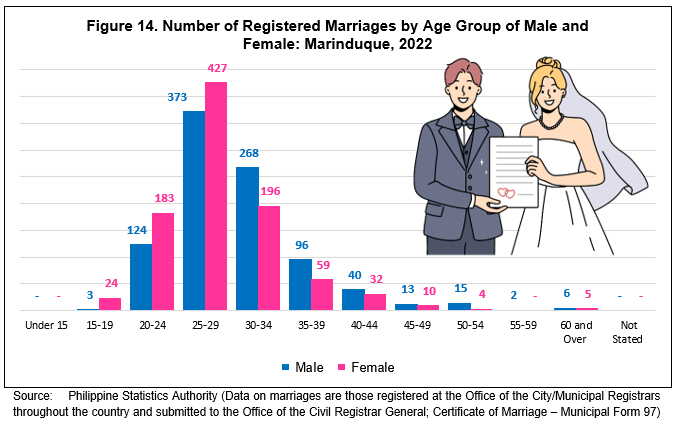
Men recorded a higher number of deaths in 2022
In Marinduque, there was a total of 1,691 deaths, including three maternal deaths and 43 infant deaths. Of the total number of deaths, 944 were men and 747 were women. (Figure 15)
Notably, the highest number of deaths was recorded for females aged 85 and over, while for males, the highest number was recorded in the 65-69 age group, indicating that, in older age group, women have a higher mortality rate than men. (Figure 16)
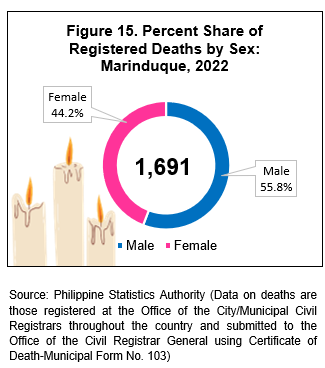
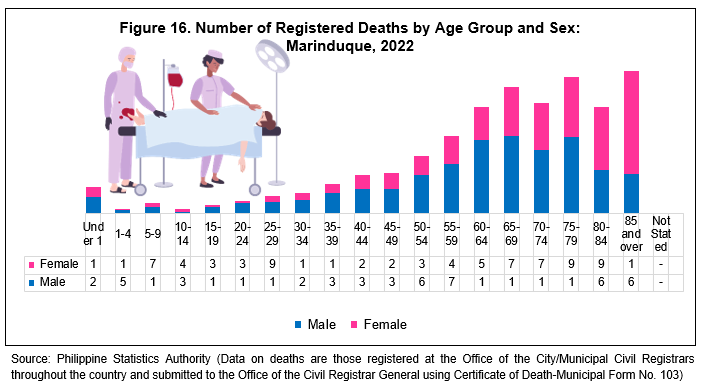
On infant deaths, there were 26 males and 16 females recorded. The recorded maternal deaths, on the other hand, occurred in the age groups 25-29 years old (1 death), 30-34 years old (1 death), and 35-39 years old (1 death), all of which were from the municipality of Boac.
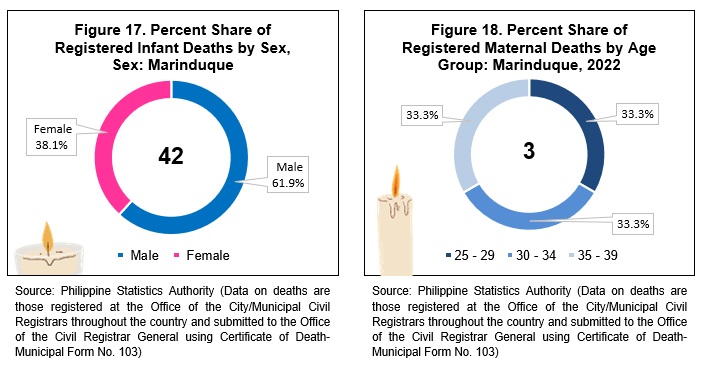
Election
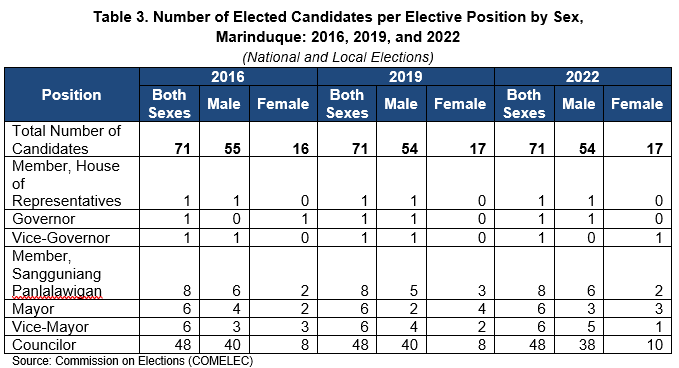
In 2022, among 71 elective positions, males held 54 positions,while females held 17, highlighting a notable gender gap. This pattern persisted in the 2016 and 2019 elections, with males dominating councilor roles. Moreover, throughout the three election periods, male candidates consistently secured key positions such as in the House of Representatives and Provincial Governor. (Table 3)
Economic Activities

In 2022, over half of the SME owners are females, with 1,443 women compared to 790 men. The same trend was observed in 2021 and 2020. Additionally, in terms of total employment within SMEs, females are consistently hired more than males. For instance, out of 3,015 total employees in 2022, 1,792 were females, highlighting their substantial presence in the workforce. (Table 4)
DEFINITION OF TERMS:
Birth – the act or process of delivering a child. It may either be a live birth or a stillbirth. (National Economic and Development Authority)
Civil Registration - is defined as the continuous, permanent and compulsory recording of the occurrences and characteristics of vital events, primarily for their value as legal documents and secondary for their usefulness as a source of statistics.
Death – refers to the permanent disappearance of all signs of life of a living person at any time. (Philippine Statistics Authority)
Death registration - is the permanent and official recording of a person’s death.
Infant mortality - is the death of an infant before his or her first birthday. The infant mortality rate is the number of infant deaths for every 1,000 live births.
Marital Status – status of an individual in relation to marriage, classified as follows:
• Single – refers to a person who has never been married;
• Married – refers to a couple living together as husband and wife, legally or consensually;
• Divorced – refers to a person whose bond of matrimony has been dissolved legally and who therefore can remarry;
• Separated – refers to a person separated legally or not from his/her spouse because of marital discord or misunderstanding; and
• Widowed – refers to a person whose bond of matrimony has been dissolved by death of his/her spouse.
Maternal death - is the death of a woman while pregnant or within 42 days of termination of pregnancy, irrespective of the duration and the site of the pregnancy, from any cause related to or aggravated by the pregnancy or its management, but not from accidental or incidental causes
Mortality Rate – generally expresses the chance that death will occur during a particular period to a person in particular population group alive at the beginning of the period. As such, those rates are true probabilities and describe precisely the risk of dying for any actual cohort. (National Economic and Development Authority)
Population – total number of individuals in a territory at a specified time. It covers both nationals and aliens, native and foreign-born persons, internees, refugees and any other group physically present within the borders of a country at a specified time. In assembling national demographic statistics for publication, the basic aim has been to obtain data for the physically present (or “de facto”) population rather than for the legally established resident (or “de jure”) inhabitants.
Household is a social unit consisting of a person or a group of persons who sleep in the same housing unit and have a common arrangement in the preparation and consumption of food.
Household population refers to all persons who are members of the household.
Sex is the biological and physiological reality of being a male or female.
Age refers to the interval of time between the person’s date of birth and his/her last birthday prior to the census reference date. It is expressed in completed years or whole numbers.
Sex ratio is the number of males per one hundred females in a population.
(SGD)GEMMA N. OPIS
Chief Statistical Specialist

